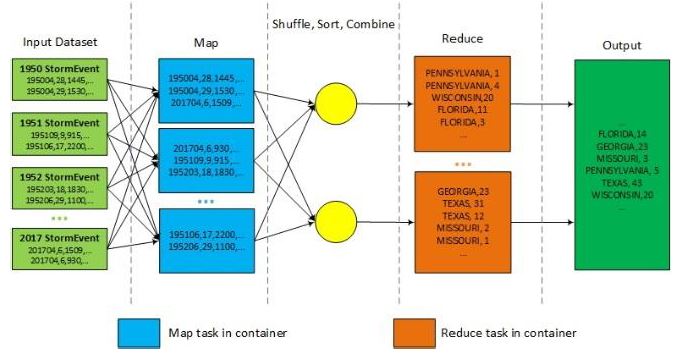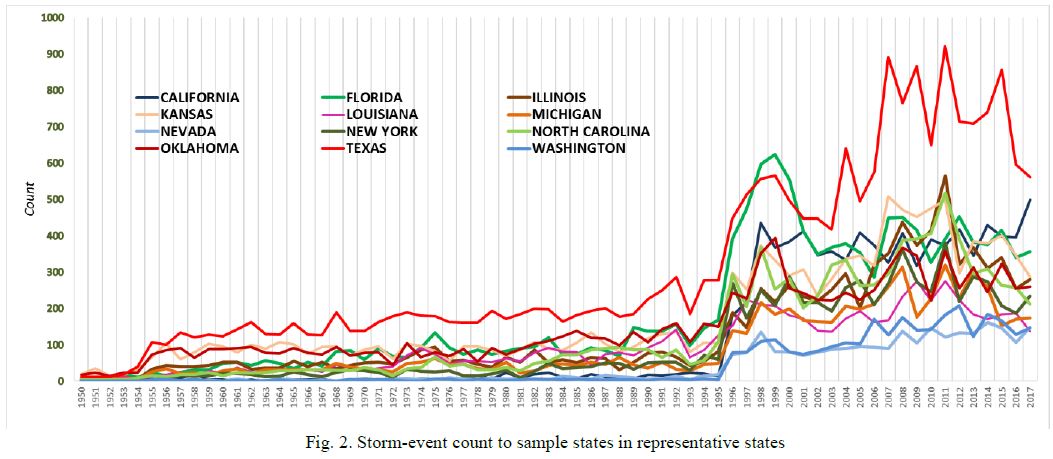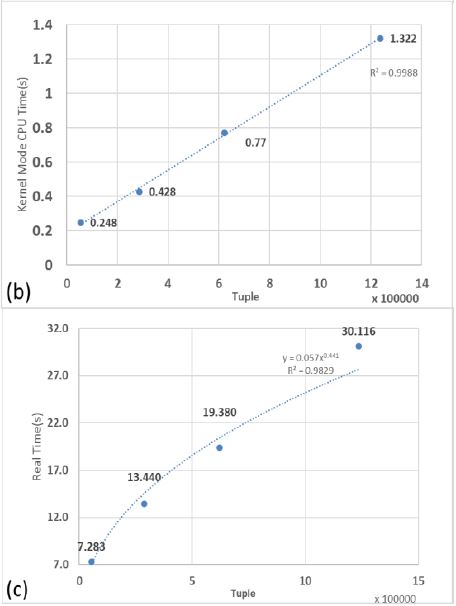Cloud Computing Application

- Map-Reduce is traditional computation framework in big data processing.
- This work use Map-Reduce framework in docker container to process the storm-event impact in the US.
- I invested the data and display the storm-event evolution trend as the indicator to climate change.
- On the other hand, the computation framework is also evaluated during the data processing.
Here is the storm-event evolution:

Below is the (b) CPU processing time and (c) framework processing time (CPU + Frame) in different input size. There exist extra overhead in map-reduce framework:

Membership Protocol and Key-value Store with C++
This job is to create membership protocal to the peers in the network and implement fault-tolerant Key-value store on top of this.
a) Membership Protocal:
- In network, Membership protocol is to detect peer’s join, failure and leave with reliable accuracy.
- Each peer received other’s status(list) and gossip their status(list) to all peers under the protocal. So the whole network will have the updating status communication.
- It must be able to handle message losses and delay simultaneously and log the peer join, leave, failure status.
b) Fault-tolerant Key-value Store:
- The peers in the network will construct a load-balancing hashing ring.
- The peers network will implement a fault-tolerant Key-value(KV) store and sustain it by peer-to-peer(P2P) communication under the membership protocal. The KV record will be stored with 3 replica (in 3 peers).
- KV store support Create, Remove, Update, Delete(CRUD) functions.
- Read and Write are based on Quorum consistency to the 3 KV replicas.
- The consitency is maintained and repaired by stabilization mechanism.
Here is protocol’s 3-layer stucture: Application, Peer-to-Peer and Emulated Network Layer.
| Layer | Job |
|---|---|
| Emulated Network | Init peer/member’s address. Send and Receive message between peer with order. Shut down the network. |
| Application | Run function to Peer start and join to network. Run application to impelment P2P membership protocal and KV store. |
| Peer-to-peer | Define the membership protocal (methods) and gossip brocasting. Deploy the KV store |
TLDR.
Below is the head file to the P2P layer major function declaration:
/**********************************
* FILE NAME: MP2Node.h
*
* DESCRIPTION: MP2Node class header file
**********************************/
#ifndef MP2NODE_H_
#define MP2NODE_H_
/**
* Header files
*/
#include "stdincludes.h"
#include "EmulNet.h"
#include "Node.h"
#include "HashTable.h"
#include "Log.h"
#include "Params.h"
#include "Message.h"
#include "Queue.h"
/**
* CLASS NAME: MP2Node
*
* DESCRIPTION: This class encapsulates all the key-value store functionality
* including:
* 1) Ring
* 2) Stabilization Protocol
* 3) Server side CRUD APIs
* 4) Client side CRUD APIs
*/
class MP2Node {
private:
// Vector holding the next two neighbors in the ring who have my replicas, from default
vector<Node> hasMyReplicas;
// Vector holding the previous two neighbors in the ring whose replicas I have, from default
vector<Node> haveReplicasOf;
// Ring, from default
vector<Node> ring;
// Hash Table, from default
HashTable * ht;
// Member representing this member, from default
Member *memberNode;
// Params object, from default
Params *par;
// Object of EmulNet, from default
EmulNet * emulNet;
// Object of Log, from default
Log * log;
// Transaction Id vector maintained by this node
vector<int> transID;//
// Map holding Transaction ID and corresponding value returned by certain READ operation (transaction ID)
map<int, vector<string>> transId_Value;//
// Transaction Pool holding Transaction ID and corresponding Operation for each transaction performed by Node
map<int, string> transactionPool;//
// Map holding Transaction ID and corresponding result for each Operation performed by transaction
map<int, vector<bool>> transId_result;//
public:
MP2Node(Member *memberNode, Params *par, EmulNet *emulNet, Log *log, Address *addressOfMember);
Member * getMemberNode() {
return this->memberNode;
}
// ring functionalities
void updateRing();
void updateNeighbor();
vector<Node> getMembershipList();
size_t hashFunction(string key);
// client side CRUD APIs, from default
void clientCreate(string key, string value);
void clientRead(string key);
void clientUpdate(string key, string value);
void clientDelete(string key);
// handle messages from receiving queue, from default
void checkMessages();
// coordinator dispatches messages to corresponding nodes, from default
void dispatchMessages(Message *message);
// Check read values and return if it has quorum
string readValue(vector<string> readreplymsg);//
// Find the addresses of nodes that are responsible for a key, called by Application.cpp, from default
vector<Node> findNodes(string key);
// Overloading findNodes: Find the neighbor of the given hashcode from localNodes
vector<Node> findNodes(size_t pos, vector<Node> replicaNodes);//
// Return element position from the given vector
int nodePositionInVector(Node elementNode, vector<Node> nodeList);//
// Whether element is present in the vector or not
bool isElement(Node elementNode, vector<Node> nodeList);//
// receive messages from Emulnet, from default
bool recvLoop();
static int enqueueWrapper(void *env, char *buff, int size);
// server, from default
bool createKeyValue(string key, string value, ReplicaType replica, int transID, Address selfAddr);
string readKey(string key, int transID, Address selfAddr);
bool updateKeyValue(string key, string value, ReplicaType replica, int transID, Address selfAddr);
bool deletekey(string key, int transID, Address selfAddr);
// stabilization protocol - handle multiple failures
void stabilizationProtocol(vector<Node> memberList); //vector<Node> memberList
// Transaction ID
int getTransactionId(vector<int> transactionID);//
~MP2Node();
};
#endif /* MP2NODE_H_ */
Other Application
- AWS EC2 implement
- HBase
- Storm

